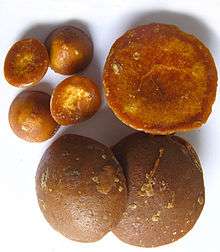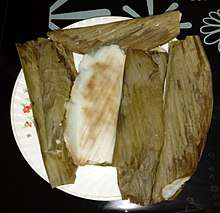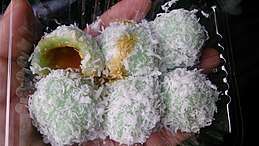Coconut sugar

Coconut sugar (also known as coco sugar, coconut palm sugar, coco sap sugar or coconut blossom sugar) is a palm sugar produced from the sap of the flower bud stem of the coconut palm. Other types of palm sugar are made from the Palmyra palm, the date palm, the sugar date palm, the sago palm or the sugar palm.
Used as a sweetener in many countries, coconut sugar has no significant nutritional or health benefits over other sweeteners.
Manufacture
Coconut sugar comes in crystal or granule form, block or liquid.
Producing coconut sugar is a two-step process.[1] It starts with harvesting or "tapping" the flower bud stem of a coconut tree.[2] Farmers make a cut on the spadix and the sap starts to flow from the cut into bamboo containers. The sap collected is then transferred into large woks and placed over moderate heat to evaporate the moisture content of the sap. The sap is translucent and is about 80% water. At this point it is known as coconut neera or nira (Indonesia), and as coconut toddy (Sri Lanka), maprau (Thailand), or lagbi (North Africa). As the water evaporates, it starts to transform into a thick sap syrup.[1] From this form, it may or may not be further reduced to crystal, block or soft paste form.
The brown colour which develops as the sap is reduced is mostly due to caramelization.[1]
Culinary use
Some Indonesian foodstuffs are made with coconut sugar, including kecap manis (a sweet soya sauce) and dendeng (a meat preparation).[1]
Gula melaka is a Southeast Asian name for palm sugar[3] or 'malacca sugar',[4] probably named for its origin in the state of Malacca, Malaysia.[5] It is usually derived from coconut palms, but sometimes from other palms.[4] It is used in savory dishes, but mainly in local desserts and cakes of the Southeast Asian region.
- A bowl of gula melaka sago
 'Patoleo' a Goan Catholic sweet dish prepared with coconut sugar
'Patoleo' a Goan Catholic sweet dish prepared with coconut sugar Klepon; the green flecks within the rice derive from glutinous rice flour mixed with sweet potato and flavored with pandan.
Klepon; the green flecks within the rice derive from glutinous rice flour mixed with sweet potato and flavored with pandan. Klepon, with palm sugar filling.
Klepon, with palm sugar filling.
Taste and flavor
Coconut sugar is subtly sweet almost like brown sugar but with a slight hint of caramel. The flavor and sweetness is usually similar to table sugar or brown sugar.[2][6] However, since coconut sugar is not highly processed, the color, sweetness and flavor can vary depending on the coconut species used, season when it was harvested, where it was harvested and/or the way the "sap" or "toddy" was reduced.
Nutrition and health claims
Although its use has become more common in developed countries, where it may be perceived as a natural sweetener,[7] there is no scientific evidence that coconut sugar is more nutritious or healthier than any other sweetener. The nutritive value is similar to the empty calories found in table sugar or brown sugar.[2][6] The major component of coconut sugar is sucrose (70–79%), glucose, and fructose (3–9% each).[2]
The glycemic index (GI) of coconut sugar was reported by the Philippine Coconut Authority to be 35 and by that measure is classified as a low glycemic index food.[8] However, the University of Sydney (Australia) Glycemic Index Research Service measured the GI of coconut sugar to be 54,[9] and considers any GI over 55 to be high.[10]
See also
- Jaggery, a form of brown sugar, is sometimes made from coconut sugar
- Gula melaka, a form of palm sugar, is frequently coconut sugar.[4]
- Coconut palm sugar is a type of palm sugar
References
- 1 2 3 4 Purnomo H (2007). "Volatile Components of Coconut Fresh Sap, Sap Syrup and Coconut Sugar" (PDF). ASEAN Food Journal. 14 (1): 45–49.
- 1 2 3 4 Beck L (16 June 2014). "Coconut sugar: Is it healthier than white sugar, or just hype?". The Globe & Mail. Retrieved 30 May 2015.
- ↑ Wee, S. (2012). Growing Up In A Nyonya Kitchen: Singapore Recipes from my Mother. Marshall Cavendish International (Asia) Private Limited. p. 38. ISBN 978-981-4435-00-0. Retrieved April 22, 2017.
- 1 2 3 Eckhardt, Robyn (January 10, 2017). "Confessions of a Palm Sugar Addict". Saveur. Retrieved April 22, 2017.
- ↑ Loh, A. (2015). Malacca Reminiscences. Partridge Publishing Singapore. p. 254. ISBN 978-1-4828-5489-3. Retrieved April 22, 2017.
- 1 2 "Coconut palm sugar". American Diabetes Association. 2015.
- ↑ Shallow, Parvati (6 November 2014). "The trendiest foods for 2015". CBS News. Retrieved 1 October 2017.
- ↑ "Glycemic Index of Coco Sugar" (PDF). Food and Nutrition Research Institute, Republic of Philippines. Retrieved 2014-02-23.
- ↑ "Glycemic index of coconut sugar". Glycemic Index Research Service, Boden Institute of Obesity, Nutrition, Exercise and Eating Disorders, University of Sydney, Australia. 2011.
- ↑ "Glycemic index". Glycemic Index Research Service, Boden Institute of Obesity, Nutrition, Exercise and Eating Disorders, University of Sydney, Australia. 2017. Retrieved 6 December 2017.